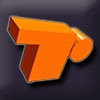 |
|
Reviews, updates and in depth guides to your favourite mobile games - AppGamer.com
|
|
with some regard to the "oxeanic" post |
|
| Page: 1 | Reply |
| Jul 8th 2001 | #7875 Report |
 Posts: 374 |
someone mentioned something about turning a logo into a vector in illustrator...can someone give me a quick run down of what that is or does? i just got illustrator and am not quite sure what to do with it thanks |
| Reply with Quote Reply | |
| Jul 8th 2001 | #7878 Report |
 Posts: 1501 |
First, a couple of descriptive explanations, pasted from http://www.wfubmc.edu/biomed/infonotes/raster_vector.html : InfoNotes: Raster vs. Vector Images All computer graphic programs fall into two basic categories: paint programs and drawing programs. A paint program works with pixels whereas a drawing program works with vectors. A pixel is a picture element, and collectively those pixels make up a raster image. Programs such as Photoshop, PaintShop, and PhotoPaint all work with pixels or raster images and therefore fall into the paint program category. Vector objects are made of lines and curves that are defined mathematically in the computer. Programs such as PowerPoint, Illustrator, Freehand, and CorelDraw all work with vectors and therefore fall into the drawing program category. Vectors can have various attributes such as line thickness, color and length. For example, in a drawing program, a square is drawn as four lines connected at the corners. Those lines can be set to different thickness and colors. The square can be hollow or filled. A line is one object with attributes, and you work with this line as a single object, not as a group of pixels as you would in a paint program. Even though word processing programs are not drawing programs, they too use vectors because they use fonts and fonts are vectors also! Have you ever make really big text in a word processor? You were enlarging vectors when you did that. In a paint program, a square is drawn as a grid of pixels (dots) and each of those pixels will have a specific color value. A line is made up of a row of pixels with each pixel having a color value, and you work with this line by working with the group of pixels that makes up the line, not as a single object as you would in a drawing program. A vector graphic is resolution-independent. (Remember that, it will be on the test!) Vectors are resolution-independent because the vector objects are drawn mathematically in the computer. They can be made larger or smaller without any loss of quality to the image. Vectors can be printed at any size, on any output device, at any resolution, without losing detail and without altering the resolution of the image. A raster image is resolution-dependant. (Yes, that too will be on the test!) Raster images are resolution-dependant because they contain a fixed number of pixels that are used to create the image. They will lose quality if enlarged beyond the number of pixels needed in a particular use. Since there is a fixed and therefore a limited number of pixels, the image becomes fuzzy as it is enlarged. For a better understanding about how pixels affect resolution, please see our InfoNotes article, "What is File Resolution?". Vector images are the best choice for typefaces, charts and graphs, drawings, and other graphics that must have sharp lines when scaled to various sizes. Raster images are the best choice for creating subtle gradations of shades and color, such as in a photograph or in a computer-generated painting. Those are things that cannot be done with vectors. Just be sure to have enough pixels in the raster image in order to get the best quality. It really comes down to using the right tool for the job. A screwdriver and a hammer are both tools but each with their own specific purpose. Think of a vector drawing program as one type of tool and a raster paint program as another type of tool. Each program has its specific purpose. You would not type a letter using Photoshop, but neither are you going to make a photo realistic image using WordPerfect. They are two different tools. Use them for their intended purpose. So in essence, what the "mentioning person" was talking about is defining the different elements in a raster image by tracing their outlines using Illustrator's vector creation and manipulation tools. This can be fairly easy to next–to–impossible, depending upon the complexity of the raster image you're starting with. The upside is that a vector image can be scaled to any size without losing image quality. Standard practice is to create logos using a vector application in the first place. You'll need to become intimate with your Illustrator user manual, and plan on spending some large chunks of quality time learning Illustrator's tools. The initial learning curve might seem steep, but it'll be some of the best education you can give yourself. |
| Reply with Quote Reply | |
| Jul 9th 2001 | #7976 Report |
 Posts: 374 |
thanks a lot bro, i really appreciate it
|
| Reply with Quote Reply | |
| Page: 1 | Back to top |
| Please login or register above to post in this forum |
| © Web Media Network Limited. All rights reserved. No part of this website may be reproduced without written permission. Photoshop is a registered trademark of Adobe Inc.. TeamPhotoshop.com is not associated in any way with Adobe, nor is an offical Photoshop website. |